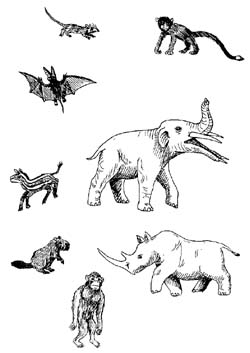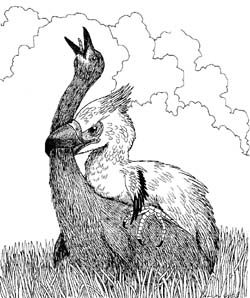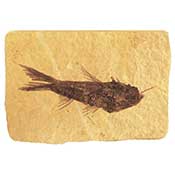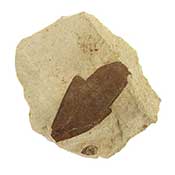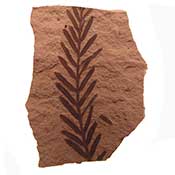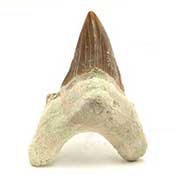Sign up for Lesson Plans, discounts & more!
The Paleogene Period
The Beginning of The Cenozoic Era
The Paleogene Period marks the beginning of the Cenozoic Era. It began 65 million years ago and lasted more than 40 million years. The Paleogene is made up of three epochs:
- The Paleocene Epoch
- The Eocene Epoch
- The Oligocene Epoch
Each epoch has unique characteristics for climate, geography, plants and animals.
Era |
Periods |
Epochs |
Millions of Years Ago |
C E N O Z O I C |
Neogene |
Holocene |
11,000 yrs ago to present |
Pleistocene |
1.8 mya to 11,000 yrs ago |
||
Pliocene |
5 to 1.8 mya |
||
Miocene |
24 to 5 mya |
||
|
Paleogene |
Oligocene |
38 to 24 mya |
|
Eocene |
54 to 38 mya |
||
Paleocene |
65 to 54 mya |
Naming the Periods of the Cenozoic
In the early 1800’s, the system for naming geologic time had only four periods. The periods were named using the Latin words for first, second, third and fourth. The word tertiary means “third.” It was the third period in the old naming system and the first part of the Cenozoic Era. The name Tertiary is still used for the early Cenozoic, even though we have a new naming system. Today we use Paleogene for the first part. Look at the chart below to compare the new system with the old.
Era |
Periods |
Epochs |
Traditional periods |
C E N O Z O I C |
Neogene |
Holocene |
Quaternary |
Pleistocene |
|||
Pliocene |
Tertiary |
||
Miocene |
|||
|
Paleogene |
Oligocene |
||
Eocene |
|||
Paleocene |
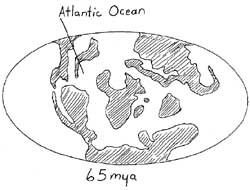
The Climate of the Paleogene Period
The beginning of the Paleogene Period was very warm and moist compared to today’s climate. Much of the earth was tropical or sub-tropical. Palm trees grew as far north as Greenland!
By the end of the Paleogene, during the Oligocene Epoch, the climate began to cool.
The Geography of the Paleogene
On the chart below are some of the major geographic events of the Paleogene. Notice that on this chart, and on most charts of geologic time, the oldest time is located at the bottom.
Epoch |
Geographic event |
The Oligocene |
|
The Eocene |
|
The Paleocene |
|
This is how the earth looked at the beginning of the Paleogene Period. Look at the bottom of the chart. See if you can find the geographic events from the Paleocene Epoch. As you read the chart from the bottom to the top, try to imagine the continents moving into their present-day locations.
The Rise of The Mammals
The plants of the Paleogene Period are very similar to the plants that we have on earth today. The warm climate at the beginning of the period was perfect for the dense forest plants. As the climate cooled, open woodlands and grasslands became abundant. The grasses were important because they supported huge herds of grazing animals.
The extinction event at the close of the Cretaceous Period wiped out the dinosaurs, large reptiles, and many other species. This left room for new animals to develop. Mammals became the dominant animals. In fact, the Cenozic Era is often called the Age of Mammals. Most of the main groups of mammals were present by the Eocene Epoch. With the dinosaurs and other large reptiles gone, mammals grew in size, numbers, and diversity. They filled ecological niches in the sea, on land and in the air.
The Appearance of Common Mammals
Many of the animals that we know today evolved during the Paleogene Period. On the chart below you will see familiar animals and the epochs when they first appeared.
Epoch |
Appearance of Mammals |
Oligocene |
|
Eocene |
|
Paleocene |
|
Terror Birds in the Paleogene
The Paleogene Period favored
the birds. New species evolved. There were many large flightless birds
that are now extinct including the Terror Birds. These birds did particularly well until the
mammals developed so many species. Many of the birds we know today were
present in the Paleogene Period.
The terror Birds were huge predators that roamed the forests and plains of the Paleogene. They belonged to the family called Phorusrhacids. They could be as much as 10 feet tall! There were many species most of them originated in South America. Later in the Neogene some of them migrated to North America once the Americas were connected at Panama. Large mammal predators had not yet evolved early in the Paleogene so there was little competition and the big birds dominated.
The Oceans And Lakes of the Paleogene
In the oceans, fish species branched out. Sharks became more plentiful. Trout and bass evolved along with many other fresh water species of fish. Huge lakes formed in the western United States during the Eocene Epoch. The Green River Formation is a famous fossil rich area created by these lakes. Many kinds of fossil fish are found in this rock formation today.
Mammals developed in the oceans, too. Primitive whales, one of the largest mammals, began to develop at this time.
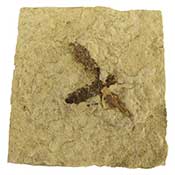
Insects
The insect population increased in the Paleogene Period. Bees and other insects that lived on the pollen and nectar of the flowering plants increased in numbers and variety.
Climate Change
The Paleogene Period had begun with a hot and humid climate, but the climate was becoming cooler and drier. The cooler temperatures were the signal of many changes coming to the earth. The thick tropical forests would not be able to survive the cooler, drier climate.
If we could go back in time and feel the climate at the end of the Paleogene, we would say it was quite warm. Compared to our climate today, it was still pretty hot! The plants and animals could feel the changing climate and as time marched into the next period, many of them would have to adapt or die.
The Paleogene Period is the begining of the old Tertiary
Interested in fossils from the Paleogene Period? Those listed below are some of the Paleogene fossils available for sale from our sister site fossilicious.com.
Check out some of the Educational Materials for sale on our sister site fossilicious.com.

interested in more? If so, you may want to check out our other sites:
fossilicious.com - Our online fossil and mineral rock shop.
rocksandminerals4u.com - An educational site about rocks, minerals, and geology.
Geologic Time Geologic Time Line
Cenozoic Era
Quaternary
Neogene
Paleogene
Mesozoic Era
Cretaceous
Jurassic
Triassic
Paleozoic Era
Permian
Carboniferous
Devonian
Silurian
Ordovician
Cambrian
Archean Time
Hadean Time
Teachers Resources
Activities for Education and Fun
Earth Science Lesson Plans
Activities For Kids
Fossil Lesson Plans
Fossil Activities
Education Articles
Coloring Pages
Dinosaur Coloring Pages
Montessori Materials
Geology Club
Fossil Hunting
 |
 |
 |
